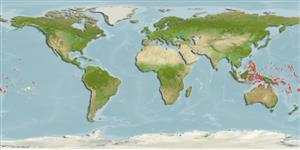>
Blenniiformes (Blennies) >
Blenniidae (Combtooth blennies) > Salariinae
Etymology: Blenniella: Diminutive of blennius, Greek,blenios = mucus (Ref. 45335).
More on author: Günther.
Environment: milieu / climate zone / depth range / distribution range
Sinh thái học
Biển Cùng sống ở rạn san hô; Mức độ sâu 0 - 3 m (Ref. 90102). Tropical; 16°N - 24°S
Pacific Ocean: southern Japan to the Moluccas, east to Mariana Islands, Tonga, and Tuamoto Archipelago; Tawara, Kiribati and Howland Island. Replaced by Blenniella cyanostigma in the Indian Ocean (Ref. 37816).
Bộ gần gũi / Khối lượng (Trọng lượng) / Age
Maturity: Lm ? range ? - ? cm
Max length : 8.2 cm SL con đực/không giới tính; (Ref. 9962); 6.8 cm SL (female)
Các tia vây lưng cứng (tổng cộng) : 12 - 14; Các vây lưng mềm (tổng cộng) : 19 - 22; Tia cứng vây hậu môn: 2 - 3; Tia mềm vây hậu môn: 20 - 23; Động vật có xương sống: 37 - 40. Diagnosis: Dorsal fin XII-XIV, 19-22, notched between spinous and segmented-ray portions; anal fin II-III, 20-23 (rarely 23); pectoral rays 12-15 (usually 14); pelvic fin I, 3; caudal fin procurrent rays 10-16, segmented rays 13. Vertebrae 10-12 + 26-29. Last pleural rib on 11-13th vertebrae. Orbital cirrus simple filamentous; nasal cirri short and simple to palmate with 2-7 branches; nape without cirri. Lateral line, continuous anterodorsally below dorsal spines from 6-7th to 10th, disconnected posteroventrally up to below dorsal spine 9-13th. Mandibular pores 3-7 Lips margin entire. Occipital crest present, higher in males (Ref. 9962). Body depth at anal-fin origin 5.8-7.3 in SL. Male crest yellow; body greyish, shading ventrally to white, with 9 brown or olive vertical bars on side, and some horizontal streaks on middle of body (Ref. 90102). Females have numerous longitudinal pinstripes on their sides and black specks on their fins while males have dark patches and small blue spots on their sides (Ref. 37816).
Adults inhabit exposed shallow shores (0-3 m) and often found in tidepools (Ref. 90102). Oviparous. Eggs are demersal and adhesive (Ref. 205), and are attached to the substrate via a filamentous, adhesive pad or pedestal (Ref. 94114). Larvae are planktonic, often found in shallow, coastal waters (Ref. 94114).
Life cycle and mating behavior
Maturities | Sự tái sinh sản | Spawnings | Egg(s) | Fecundities | Ấu trùng
Distinct pairing (Ref. 205).
Springer, V.G. and J.T. Williams, 1994. The Indo-West Pacific blenniid fish genus Istiblennius reappraised: a revision of Istiblennius, Blenniella, and Paralticus, new genus. Smithson. Contrib. Zool. 565:1-193. (Ref. 9962)
IUCN Red List Status (Ref. 130435)
Threat to humans
Harmless
Human uses
Các công cụ
Special reports
Download XML
Các nguồn internet
Estimates based on models
Preferred temperature (Ref.
123201): 26.7 - 29.4, mean 28.7 °C (based on 908 cells).
Phylogenetic diversity index (Ref.
82804): PD
50 = 0.5020 [Uniqueness, from 0.5 = low to 2.0 = high].
Bayesian length-weight: a=0.00741 (0.00335 - 0.01640), b=3.02 (2.83 - 3.21), in cm total length, based on LWR estimates for this (Sub)family-body shape (Ref.
93245).
Mức dinh dưỡng (Ref.
69278): 2.8 ±0.3 se; based on size and trophs of closest relatives
Thích nghi nhanh (Ref.
120179): Chiêù cao, thời gian nhân đôi của chủng quần tối thiểu là dưới 15 tháng (Preliminary K or Fecundity.).
Fishing Vulnerability (Ref.
59153): Low vulnerability (10 of 100).
Nutrients (Ref.
124155): Calcium = 191 [89, 351] mg/100g; Iron = 0.902 [0.484, 1.651] mg/100g; Protein = 17.9 [16.6, 19.1] %; Omega3 = 0.0717 [, ] g/100g; Selenium = 16.5 [7.3, 39.6] μg/100g; VitaminA = 133 [31, 574] μg/100g; Zinc = 2.93 [1.85, 4.49] mg/100g (wet weight);
